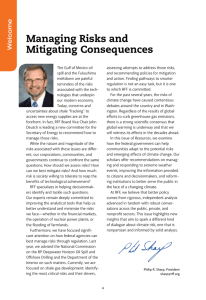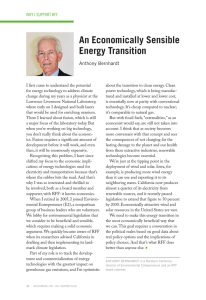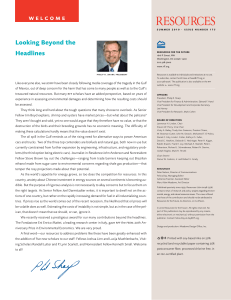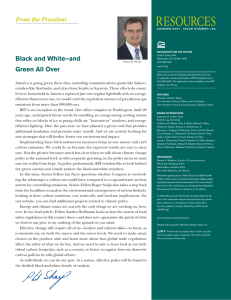Looking Beyond the Obvious
advertisement
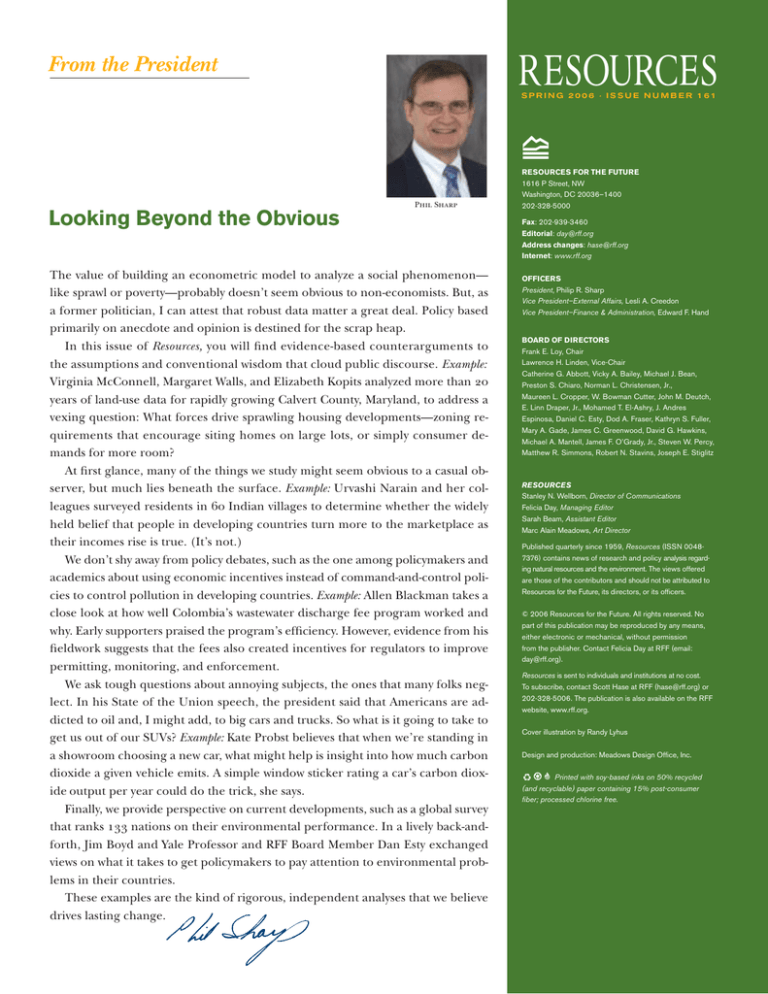
RESOURCES From the President SPRING 2006 · ISSUE NUMBER 161 Phil Sharp Looking Beyond the Obvious The value of building an econometric model to analyze a social phenomenon— like sprawl or poverty—probably doesn’t seem obvious to non-economists. But, as a former politician, I can attest that robust data matter a great deal. Policy based primarily on anecdote and opinion is destined for the scrap heap. In this issue of Resources, you will find evidence-based counterarguments to the assumptions and conventional wisdom that cloud public discourse. Example: Virginia McConnell, Margaret Walls, and Elizabeth Kopits analyzed more than 20 years of land-use data for rapidly growing Calvert County, Maryland, to address a vexing question: What forces drive sprawling housing developments—zoning requirements that encourage siting homes on large lots, or simply consumer demands for more room? At first glance, many of the things we study might seem obvious to a casual observer, but much lies beneath the surface. Example: Urvashi Narain and her colleagues surveyed residents in 60 Indian villages to determine whether the widely held belief that people in developing countries turn more to the marketplace as their incomes rise is true. (It’s not.) We don’t shy away from policy debates, such as the one among policymakers and academics about using economic incentives instead of command-and-control policies to control pollution in developing countries. Example: Allen Blackman takes a close look at how well Colombia’s wastewater discharge fee program worked and why. Early supporters praised the program’s efficiency. However, evidence from his fieldwork suggests that the fees also created incentives for regulators to improve permitting, monitoring, and enforcement. We ask tough questions about annoying subjects, the ones that many folks neglect. In his State of the Union speech, the president said that Americans are addicted to oil and, I might add, to big cars and trucks. So what is it going to take to get us out of our SUVs? Example: Kate Probst believes that when we’re standing in a showroom choosing a new car, what might help is insight into how much carbon dioxide a given vehicle emits. A simple window sticker rating a car’s carbon dioxide output per year could do the trick, she says. Finally, we provide perspective on current developments, such as a global survey that ranks 133 nations on their environmental performance. In a lively back-andforth, Jim Boyd and Yale Professor and RFF Board Member Dan Esty exchanged views on what it takes to get policymakers to pay attention to environmental problems in their countries. These examples are the kind of rigorous, independent analyses that we believe drives lasting change. RESOURCES FOR THE FUTURE 1616 P Street, NW Washington, DC 20036–1400 202-328-5000 Fax: 202-939-3460 Editorial: day@rff.org Address changes: hase@rff.org Internet: www.rff.org OFFICERS President, Philip R. Sharp Vice President–External Affairs, Lesli A. Creedon Vice President–Finance & Administration, Edward F. Hand BOARD OF DIRECTORS Frank E. Loy, Chair Lawrence H. Linden, Vice-Chair Catherine G. Abbott, Vicky A. Bailey, Michael J. Bean, Preston S. Chiaro, Norman L. Christensen, Jr., Maureen L. Cropper, W. Bowman Cutter, John M. Deutch, E. Linn Draper, Jr., Mohamed T. El-Ashry, J. Andres Espinosa, Daniel C. Esty, Dod A. Fraser, Kathryn S. Fuller, Mary A. Gade, James C. Greenwood, David G. Hawkins, Michael A. Mantell, James F. O’Grady, Jr., Steven W. Percy, Matthew R. Simmons, Robert N. Stavins, Joseph E. Stiglitz RESOURCES Stanley N. Wellborn, Director of Communications Felicia Day, Managing Editor Sarah Beam, Assistant Editor Marc Alain Meadows, Art Director Published quarterly since 1959, Resources (ISSN 00487376) contains news of research and policy analysis regarding natural resources and the environment. The views offered are those of the contributors and should not be attributed to Resources for the Future, its directors, or its officers. © 2006 Resources for the Future. All rights reserved. No part of this publication may be reproduced by any means, either electronic or mechanical, without permission from the publisher. Contact Felicia Day at RFF (email: day@rff.org). Resources is sent to individuals and institutions at no cost. To subscribe, contact Scott Hase at RFF (hase@rff.org) or 202-328-5006. The publication is also available on the RFF website, www.rff.org. Cover illustration by Randy Lyhus Design and production: Meadows Design Office, Inc. ® r ‰ Printed with soy-based inks on 50% recycled (and recyclable) paper containing 15% post-consumer fiber; processed chlorine free.



